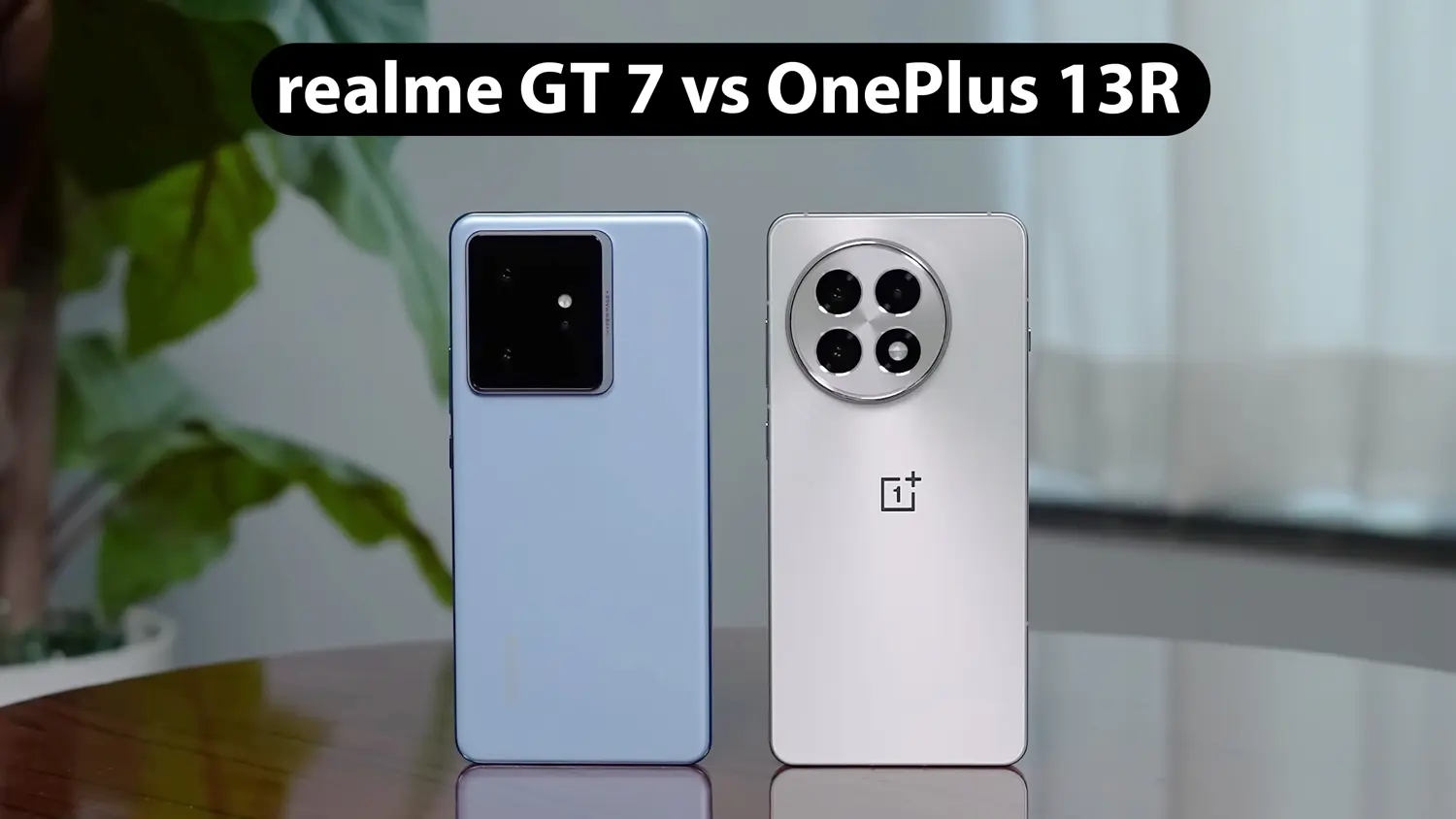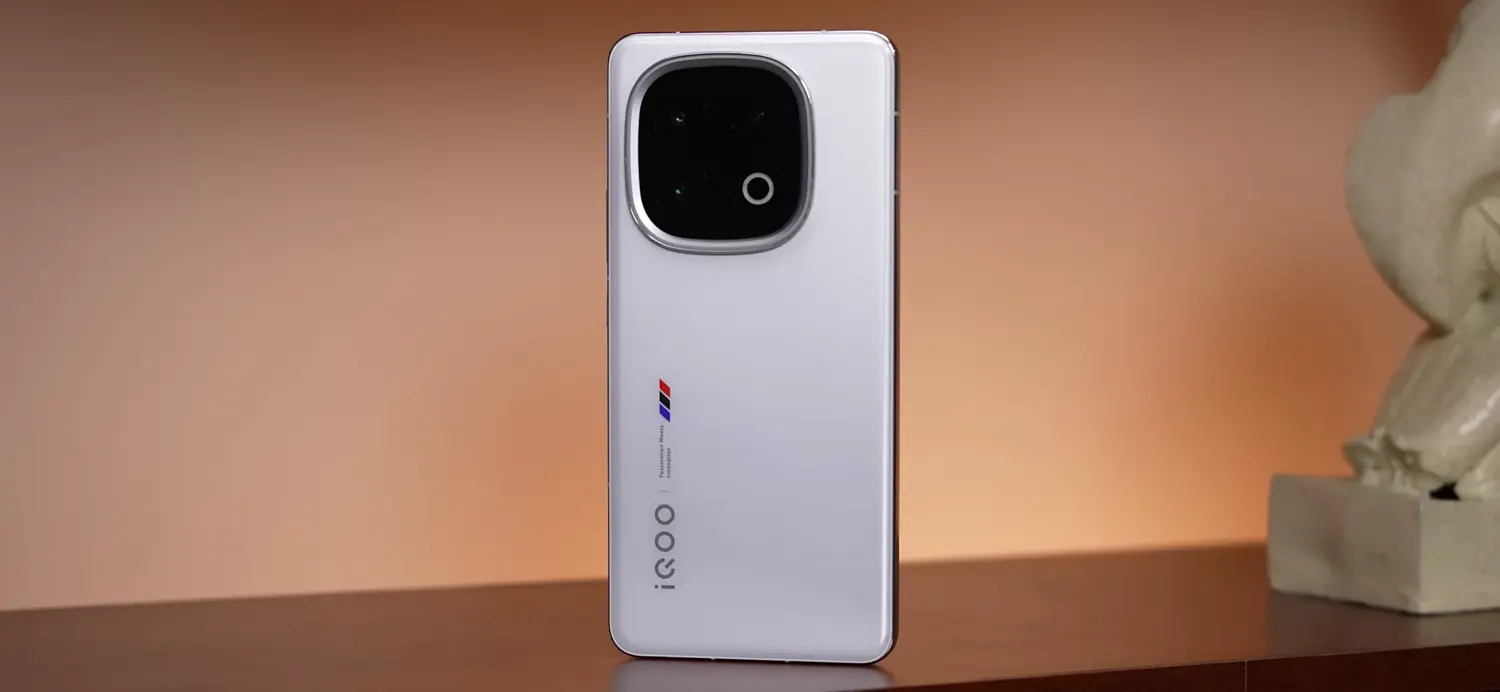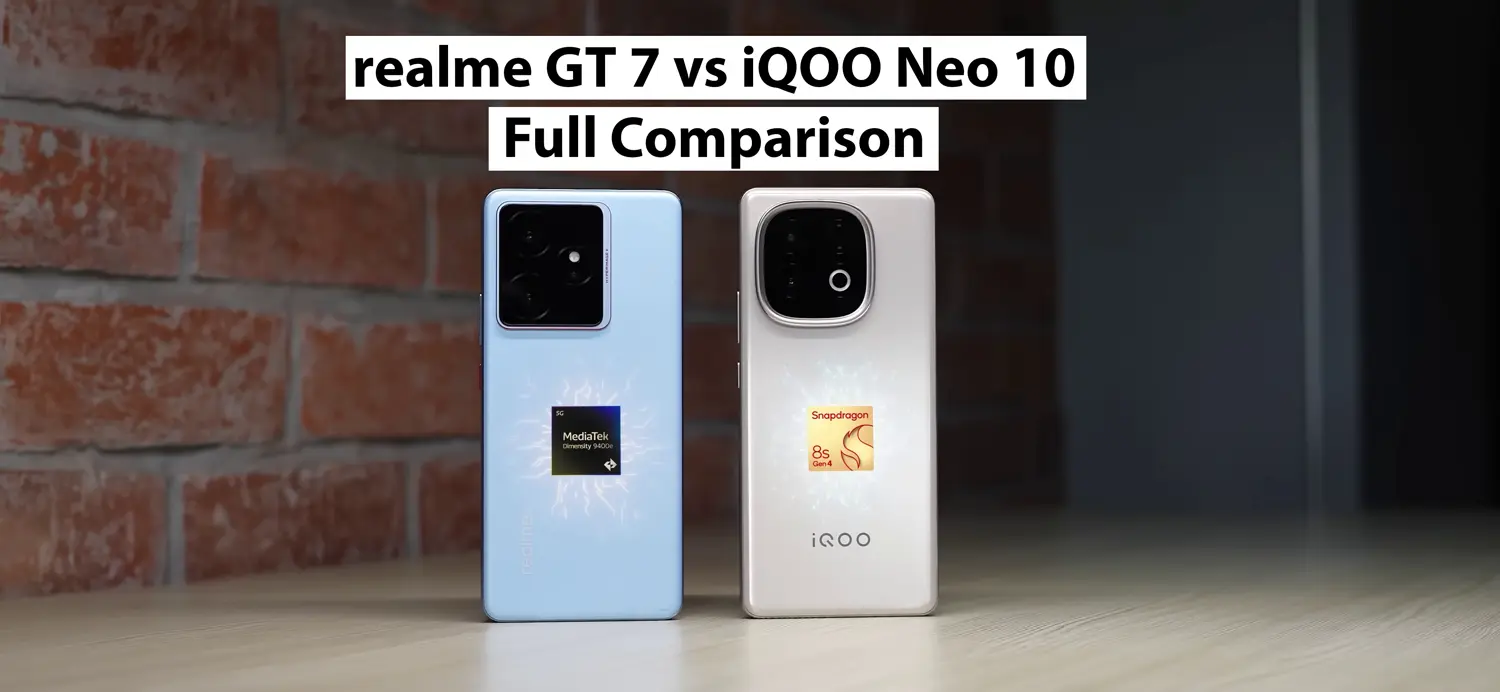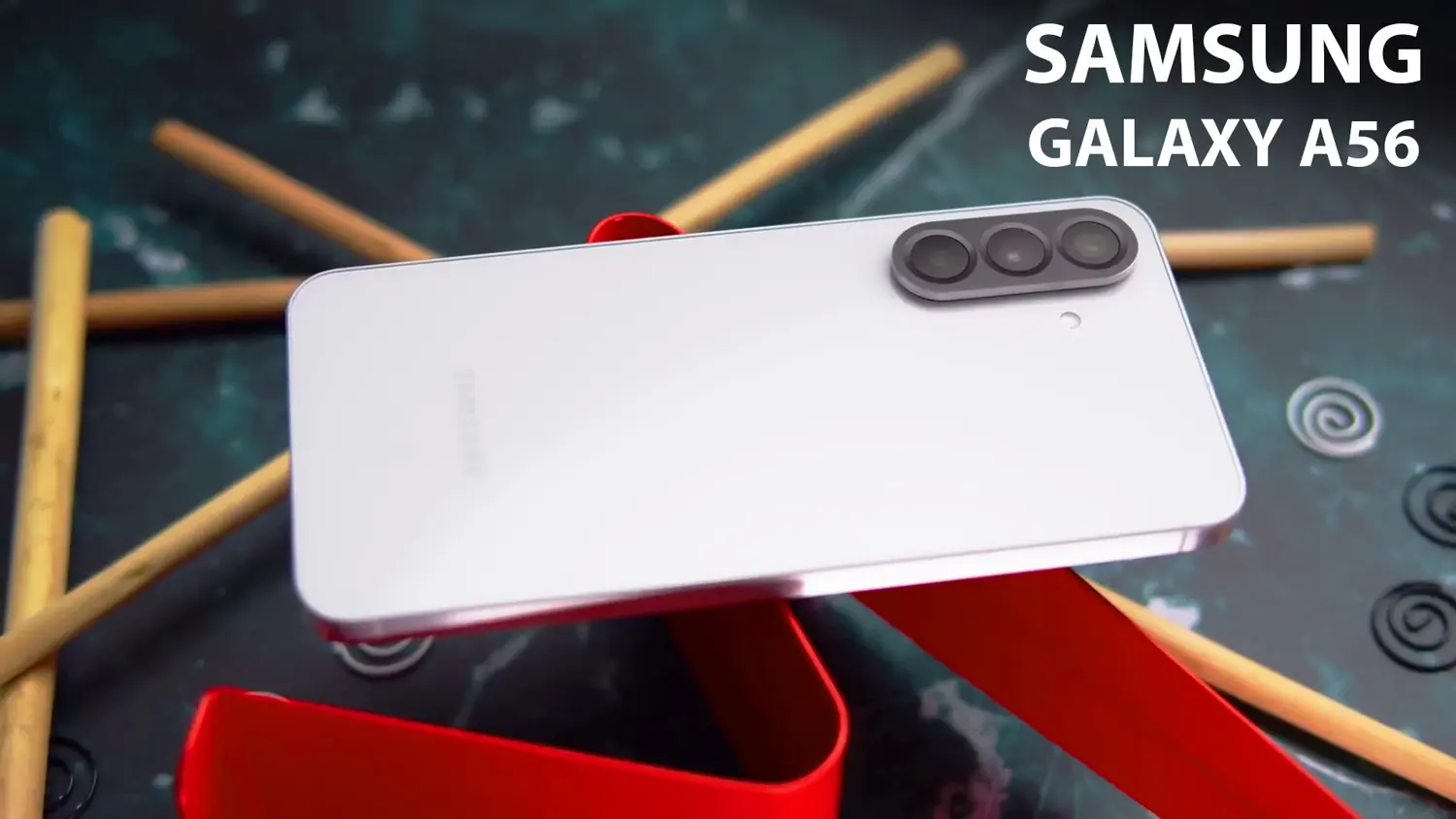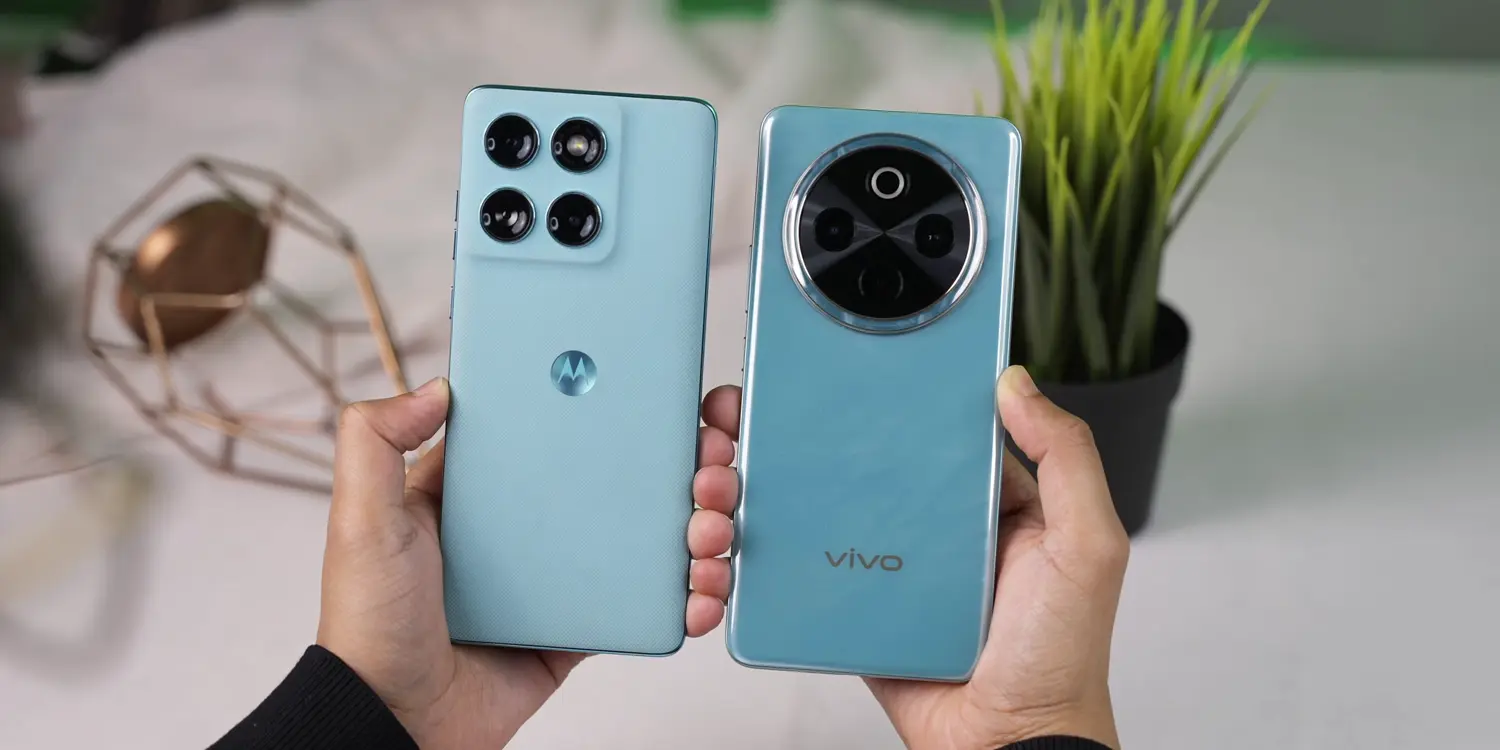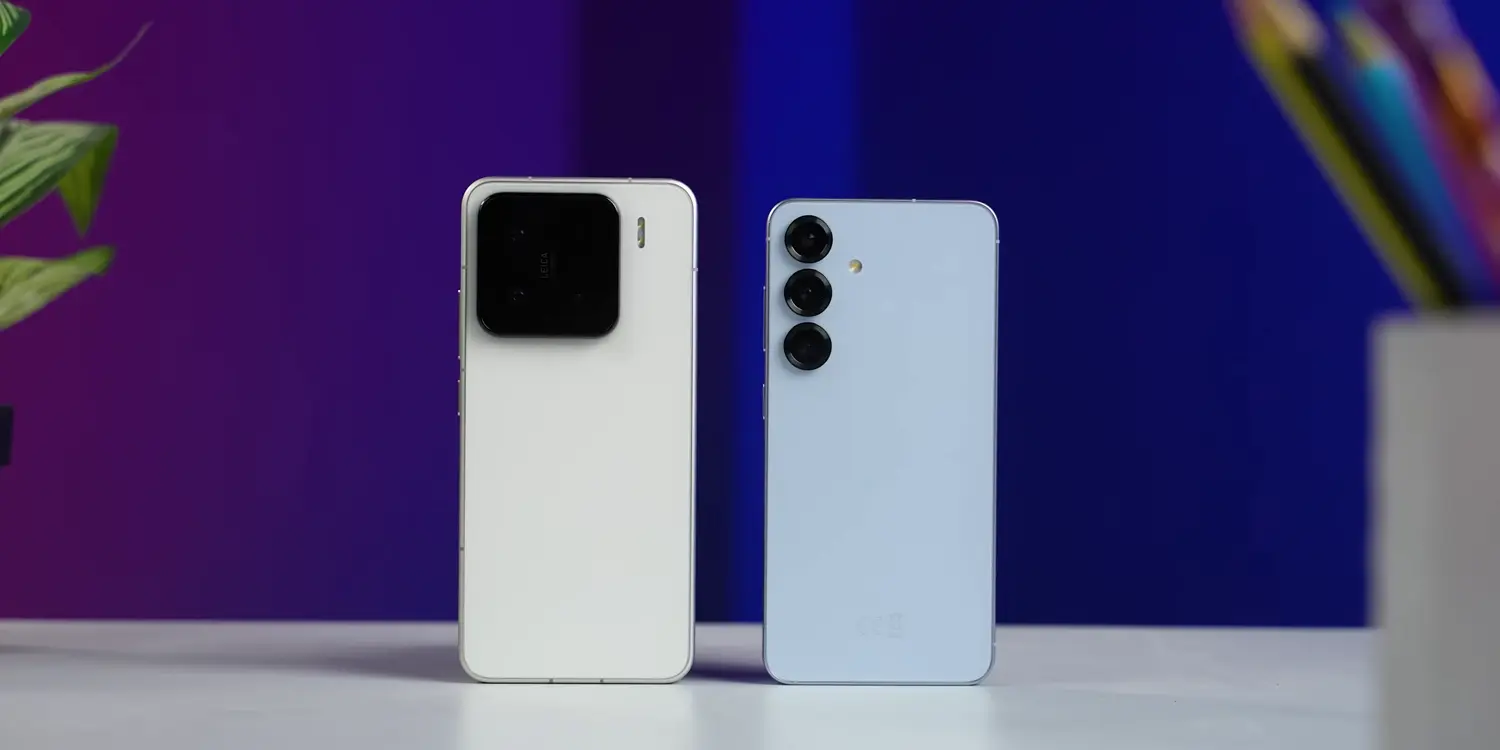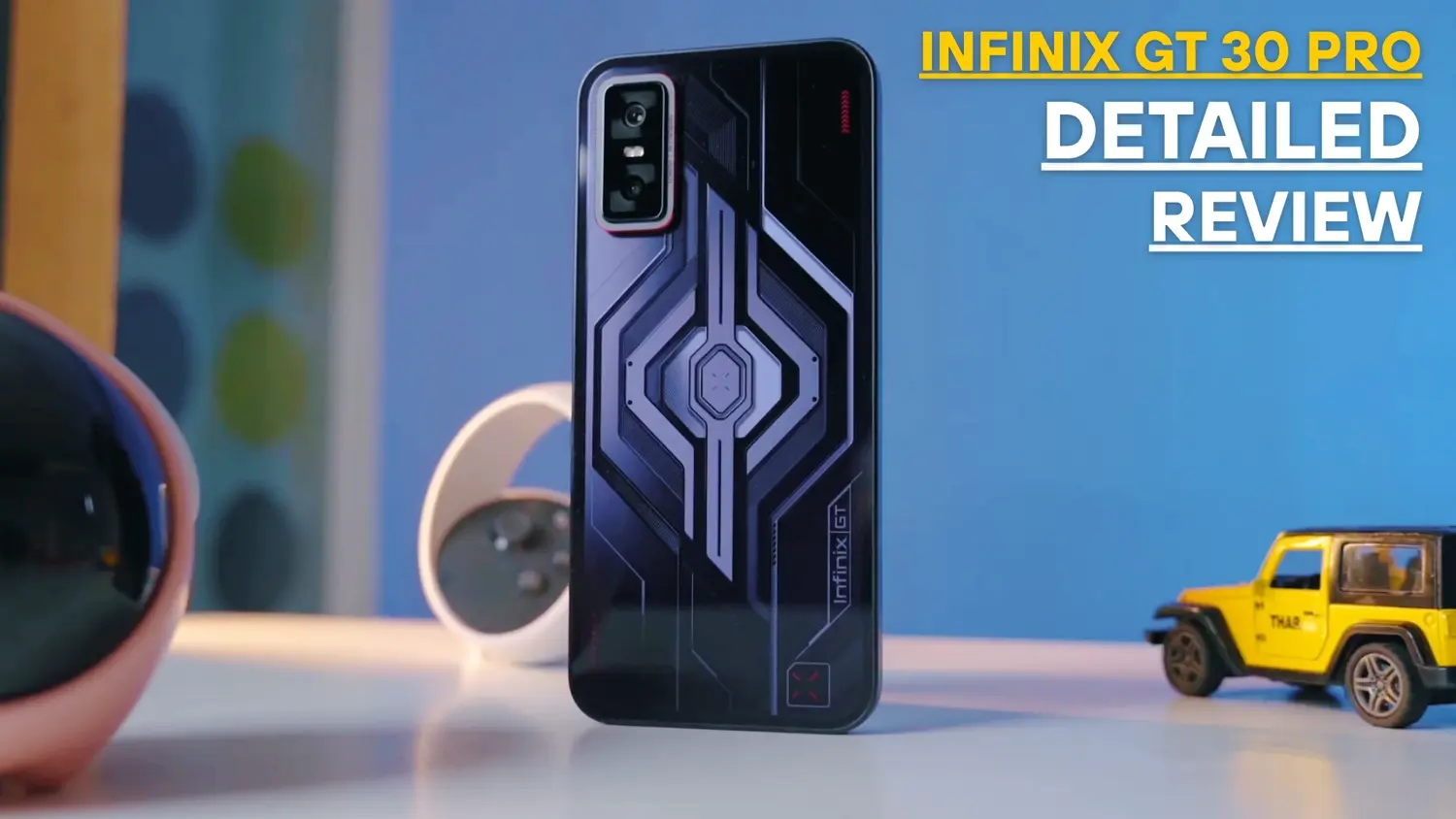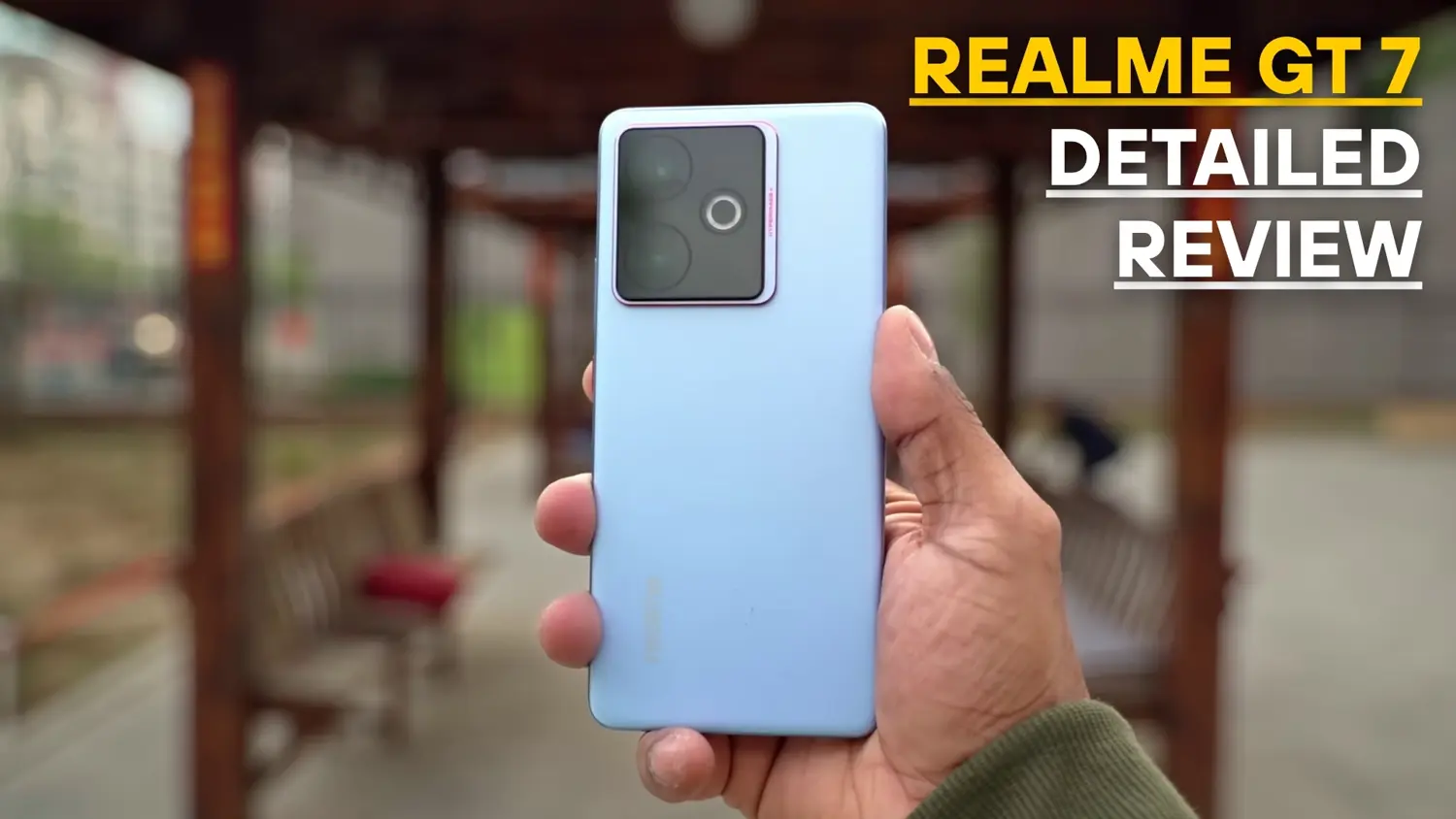The mid-premium smartphone segment is heating up with the launch of the Realme GT 7, a device that promises flagship-level performance at a competitive price. Positioned as a direct rival to the OnePlus 13R, the Realme GT 7 boasts impressive specifications, including a massive 7,000mAh battery, a MediaTek Dimensity 9400e chipset, and an IP69 rating. However, raw specifications are only part of the story—real-world performance, build quality, camera capabilities, and software experience are equally critical. This in-depth review compares the Realme GT 7 and OnePlus 13R across key aspects to help you decide which phone offers better value. If you’re exploring premium options this year, check our take on the OnePlus 13 vs Pixel 9 Pro XL.
Specifications at a Glance
Below is a detailed table comparing the key specifications of the Realme GT 7 and OnePlus 13R:
| Feature | Realme GT 7 | OnePlus 13R |
|---|---|---|
| Display | 6.78″ AMOLED, 1.5K (1264×2780), 120Hz, 6000 nits peak, 2160Hz PWM dimming | 6.78″ ProXDR AMOLED, 1.5K (1264×2780), 120Hz LTPO 4.1, 4500 nits peak, 2160Hz PWM dimming |
| Processor | MediaTek Dimensity 9400e, 3nm, Octa-Core (up to 3.3 GHz) | Qualcomm Snapdragon 8 Gen 3, Octa-Core (up to 3.3 GHz) |
| GPU | Immortalis-G720 MC12 | Adreno 830 |
| RAM/Storage | 8GB/256GB, 12GB/256GB, 12GB/512GB (LPDDR5X, UFS 4.0) | 12GB/256GB, 16GB/512GB (LPDDR5X, UFS 4.0) |
| Battery | 7,000mAh, 120W wired charging | 6,000mAh, 80W SUPERVOOC charging |
| Rear Cameras | 50MP Sony IMX906 (OIS, f/1.8), 50MP Samsung S5KJN5 (2x tele, f/2.0), 8MP ultra-wide (f/2.2) | 50MP Sony LYT-700 (OIS, f/1.8), 50MP Samsung S5KJN5 (2x tele, f/2.0), 8MP ultra-wide (f/2.2) |
| Front Camera | 32MP (f/2.45) | 16MP Sony IMX480 (f/2.4) |
| Operating System | Realme UI 6.0 (Android 15) | OxygenOS 15 (Android 15) |
| Build | Plastic frame and back, Gorilla Glass 7i, IP68/IP69 | Aluminum frame, glass back, Gorilla Glass 7i, IP65 |
| Connectivity | 5G, Wi-Fi 7, Bluetooth 5.4, NFC, USB-C 2.0 | 5G, Wi-Fi 7, Bluetooth 5.4, NFC, USB-C 2.0 |
| Weight/Thickness | ~200g, 8.3mm | ~210g, 8.5mm |
| Additional Features | Ultrasonic in-display fingerprint, AI Planner, AI Translator, AI Smart Loop | Alert Slider, LTPO display |
| Price (Base Variant) | ₹39,999 (8GB/256GB) | ₹42,999 (12GB/256GB) |
Design and Build Quality
The Realme GT 7 impresses with its ability to pack a 7,000mAh battery into an 8.3mm slim chassis, weighing approximately 200g. This is a remarkable feat, as large batteries often result in bulkier designs. The phone features a plastic frame and back with a laser-etched finish and IceSense Graphene for thermal dissipation, giving it a modern aesthetic. However, the all-plastic construction feels less premium compared to the OnePlus 13R, which sports a matte glass back and an aluminum frame, contributing to a more upscale in-hand feel despite its slightly heavier 210g weight and 8.5mm thickness.
Both phones are protected by Corning Gorilla Glass 7i, ensuring decent scratch resistance. The Realme GT 7 holds a significant advantage with its IP68/IP69 rating, offering superior water and dust resistance compared to the OnePlus 13R’s IP65 rating, which is less robust against water exposure. The OnePlus 13R, however, includes the iconic alert slider—a feature cherished by OnePlus fans but absent on the GT 7. Both devices disappoint with USB-C 2.0 ports, limiting data transfer speeds, which is a drawback for flagship-grade phones in 2025.
Verdict: The OnePlus 13R wins for premium build quality, while the Realme GT 7 excels in durability with its higher IP rating.
Display
Both the Realme GT 7 and OnePlus 13R feature 6.78-inch AMOLED displays with a 1.5K resolution (1264×2780) and a 120Hz refresh rate, delivering smooth and vibrant visuals. The GT 7 boasts a peak brightness of 6,000 nits, ideal for HDR content and outdoor visibility, while the OnePlus 13R reaches 4,500 nits with LTPO 4.1 technology, allowing dynamic refresh rates from 1Hz to 120Hz for better power efficiency. Both support 2160Hz PWM dimming, reducing flicker for sensitive users, and Dolby Vision for enhanced HDR streaming on platforms like Netflix.
In side-by-side testing, color reproduction is nearly identical due to both panels being sourced from BOE, with accurate skin tones and landscape colors. However, the OnePlus 13R occasionally appears slightly brighter when viewing HDR content on YouTube, despite its lower peak brightness. Outdoor performance is comparable, with both displays remaining legible under direct sunlight. The GT 7’s higher brightness gives it a slight edge for HDR, but the 13R’s LTPO technology makes it more efficient for everyday use.
Verdict: The Realme GT 7 edges out for HDR brightness, but the OnePlus 13R’s LTPO display offers better efficiency.
Performance and Thermal Efficiency
The Realme GT 7 is powered by the MediaTek Dimensity 9400e chipset, a 3nm processor with an Immortalis-G720 MC12 GPU, while the OnePlus 13R features the Qualcomm Snapdragon 8 Gen 3 with an Adreno 830 GPU. Both chips deliver flagship-grade performance, but they cater to different strengths. The Dimensity 9400e excels in CPU performance, scoring higher in benchmarks like AnTuTu and Geekbench, and shows better stability in 30-minute CPU throttle tests due to its powerful big and medium cores. The Snapdragon 8 Gen 3, however, has a superior GPU, resulting in better frame rates in games like Genshin Impact and higher scores in 3DMark tests.
The Realme GT 7’s thermal management is a standout, thanks to its 7,700mm² vapor cooling chamber and 4,400mm² graphene layer, keeping temperatures lower during intensive tasks. The OnePlus 13R, while not overheating, runs slightly warmer under load. Both phones feature LPDDR5X RAM and UFS 4.0 storage, ensuring fast app launches and multitasking.
Verdict: The Realme GT 7 offers superior CPU performance and thermal efficiency, while the OnePlus 13R is better for gaming due to its GPU advantage. If you’re comparing more compact powerhouses, check Xiaomi 15 vs Galaxy S25.
Battery Life and Charging
The Realme GT 7’s 7,000mAh battery is a highlight, offering exceptional endurance with up to 9 hours and 30 minutes of screen-on time in mixed usage. The OnePlus 13R’s 6,000mAh battery is no slouch, delivering around 8 hours and 30 minutes of screen-on time, but it falls short of the GT 7’s longevity. The GT 7 also supports faster 120W charging, achieving a full charge in approximately 40 minutes, compared to the 13R’s 80W SUPERVOOC charging, which takes 50–53 minutes. Neither phone supports wireless charging, a minor drawback in this segment.
Verdict: The Realme GT 7 dominates with its larger battery and faster charging.
Camera Performance
Both phones feature similar triple-camera setups: a 50MP primary sensor (Sony IMX906 on GT 7, Sony LYT-700 on 13R), a 50MP 2x telephoto (Samsung S5KJN5), and an 8MP ultra-wide. The GT 7 has a 32MP selfie camera, while the 13R uses a 16MP unit. Despite similar hardware, real-world performance differs.
- Primary Camera: The OnePlus 13R captures sharper details with less oversharpening compared to the GT 7, which tends to overprocess images. The 13R also excels in low-light photography, producing brighter images with better detail retention. However, the GT 7’s “crisp” color mode offers more natural tones compared to the 13R’s slightly cooler hues.
- Ultra-Wide and Telephoto: The 13R outperforms in ultra-wide and 2x telephoto shots, maintaining better detail and shadow recovery. The GT 7’s images can appear oversharpened, though its color consistency is superior.
- Selfie Camera: The GT 7’s 32MP front camera delivers higher-resolution selfies with better detail and skin tones in daylight, along with improved portrait edge detection. The 13R’s 16MP selfies are decent but less detailed.
- Video Recording: The GT 7 supports 4K 60fps, 4K 120fps, 8K 30fps, and 4K 60fps Dolby Vision with the primary camera, plus 4K 60fps selfies. The 13R is limited to 4K 60fps for the primary camera and 1080p 30fps for selfies. However, the 13R performs better in low-light video, offering brighter and more detailed footage.
Verdict: The Realme GT 7 is superior for video capabilities and selfie quality, while the OnePlus 13R excels in low-light photography and detail retention.
Software Experience
Both phones run Android 15, with the GT 7 featuring Realme UI 6.0 and the 13R running OxygenOS 15. Both promise 4 years of OS updates and 6 years of security updates, ensuring long-term support. OxygenOS 15 is cleaner out of the box, with minimal bloatware and no Glance integration, unlike Realme UI 6.0, which includes pre-installed apps that can be uninstalled.
Both offer similar features, including Flux themes, live activities, O+ Connect for media transfer, smart sidebar, split-screen, and AI tools like AI Eraser, AI Detail Boost, and Circle to Search. The GT 7 has additional AI features like AI Planner (adds events to your calendar from posters), AI Translator, and AI Smart Loop, giving it a slight edge for AI-driven tasks.
Verdict: Realme GT 7 offers more AI features, while OnePlus 13R provides a cleaner software experience.
Connectivity and Audio
Both phones support 5G, Wi-Fi 7, Bluetooth 5.4, NFC, and dual SIM, with excellent network performance even in areas with spotty 5G coverage. Audio quality is comparable, with stereo speakers delivering balanced sound and support for high-res codecs like LDAC and LSCD for Bluetooth audio. Haptic feedback is crisp and well-integrated on both devices, enhancing the user experience.
Verdict: Both phones are evenly matched in connectivity and audio.
Pricing and Value
The Realme GT 7 starts at ₹39,999 for the 8GB/256GB variant, with higher configurations at ₹42,999 (12GB/256GB) and ₹46,999 (12GB/512GB). The OnePlus 13R is priced at ₹42,999 for 12GB/256GB and ₹47,999 for 16GB/512GB, making the GT 7 more affordable.
Conclusion
The Realme GT 7 and OnePlus 13R are formidable contenders in the mid-premium segment, each with distinct strengths. The GT 7 shines with its massive 7,000mAh battery, faster 120W charging, superior thermal efficiency, higher IP69 rating, and advanced AI features. Its camera excels in video capabilities and selfies, with natural color reproduction in “crisp” mode. The OnePlus 13R counters with a premium glass-and-metal build, the beloved alert slider, a more efficient LTPO display, and better low-light photography and gaming performance. Still not satisfied? The Poco F7 Ultra might be the flagship killer you’re looking for.
Recommendation:
- Choose Realme GT 7 if you prioritize battery life, fast charging, durability, and AI-driven software features. It’s also the better value at a lower starting price.
- Choose OnePlus 13R if you value premium build quality, cleaner software, and superior gaming and low-light camera performance.
Both phones are excellent, and your choice depends on whether you lean toward raw power and endurance (GT 7) or premium design and gaming prowess (13R).
